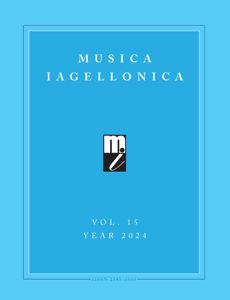«Fa ritratto alla Luna»:
la musica negli scritti di Agostino Mascardi (1590–1640)
«He paints a portrait of the Moon»:
Music in the writings of Agostino Mascardi (1590–1640)
Author(s): Marina ToffettiSubject(s): Music, History of Art, Italian literature, Sociology of Literature
Published by: Musica Iagellonica Sp. z o.o.
Keywords: Agostino Mascardi; music and rhetoric; musical quotations; musical metaphors; diffusion of musical vocabulary;
Summary/Abstract: The essay examines for the first time in a systematic way the references to music andthe musical metaphors that dot the rhetorical writings of Agostino Mascardi (1590–1640), a central figure of Roman culture in the first decades of the seventeenth century,analyzing with particular attention his speech Della dialettica e della musica (1627).In December 1621, shortly after moving to Genoa, Mascardi was appointed readerof the local Accademia degli Addormentati and began a commentary on the Tavoladi Cebete tebano, a philosophical-moral dialogue then attributed to the Pythagoreanphilosopher Cebes and now traced back to the philosophical schools of the 1st–2ndcentury AD. The work consists of the description (ecphrasis) of the images painted ina votive painting that alluded to the path that leads man to reach wisdom and virtue.The rhetorician’s commentary would flow into the Discorsi morali su la Tavola di Cebetetebano (Venice, 1627), a work divided into four parts and composed of 35 speecheswoven with quotations from the greatest ancient (Plato, Seneca, Homer, Virgil) andmodern (Dante, Petrarca, Ariosto, Tasso, Lipsius) philosophers and poets.The third speech of the third part, entitled Della dialettica e della musica (On dialecticsand music), is in fact almost entirely dedicated to the art of music and includes nume-rous quotations referring to music taken from ancient and modern poetic-literary andphilosophical works. In addition to identifying most of the sources of these references,the essay questions their meaning and notes, in this and other rhetorical writings byMascardi (such as the Orationi of 1622), the presence of numerous passages in whichmusic is evoked as a metaphor for the process of interior transformation, as well asupdated musical terms and references to modern compositional procedures or perfor-mance practice (ricercata, groppo, passaggio). Finally, a reflection is proposed on howmuch the references to music identified in Mascardi’s works can reveal about musicalculture and the way in which a prominent intellectual of the early seventeenth centuryconceived and lived the art of music.
Journal: Musica Iagellonica
- Issue Year: 15/2024
- Issue No: 1
- Page Range: 73-109
- Page Count: 37
- Language: Italian

